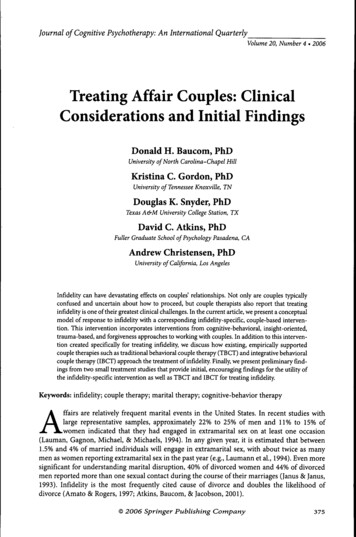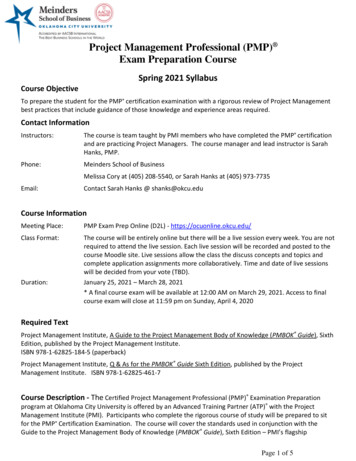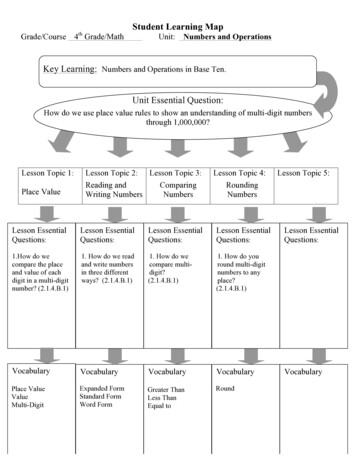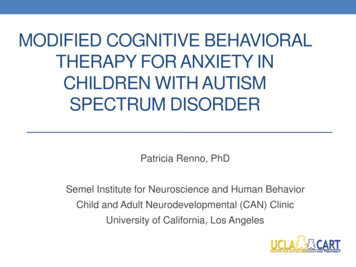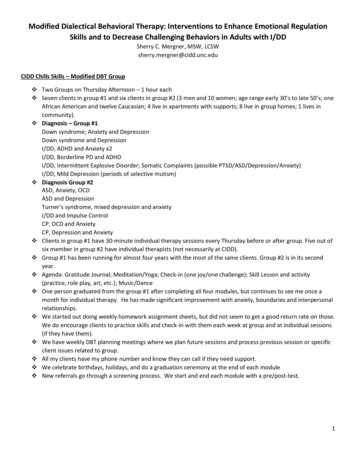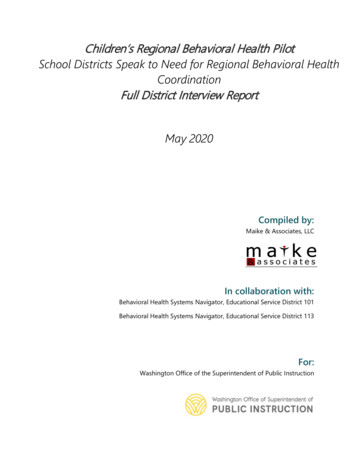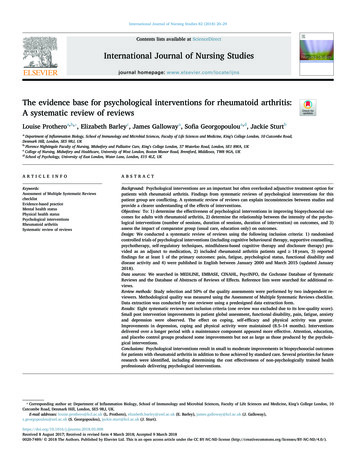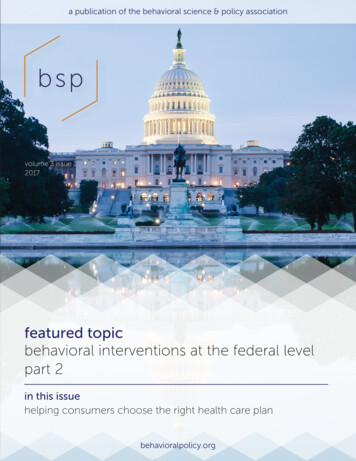
Transcription
a publication of the behavioral science & policy associationvolume 3 issue 12017featured topicbehavioral interventions at the federal levelpart 2in this issuehelping consumers choose the right health care planbehavioralpolicy.org
founding co-editorsdisciplinary editorsBehavioral EconomicsSenior Disciplinary EditorAssociate Disciplinary EditorsCraig R. Fox (UCLA)Sim B Sitkin (Duke University)bspa executive directorKate B.B. Wesselsadvisory boardPaul Brest (Stanford University)David Brooks (New York Times)John Seely Brown (Deloitte)Robert B. Cialdini (Arizona State University)Adam M. Grant (University of Pennsylvania)Daniel Kahneman (Princeton University)James G. March (Stanford University)Jeffrey Pfeffer (Stanford University)Denise M. Rousseau (Carnegie Mellon University)Paul Slovic (University of Oregon)Cass R. Sunstein (Harvard University)Richard H. Thaler (University of Chicago)executive committeeCognitive & Brain ScienceSenior Disciplinary EditorAssociate Disciplinary EditorsDecision, Marketing, & Management SciencesSenior Disciplinary EditorAssociate Disciplinary EditorsMorela Hernandez (University of Virginia)Katherine L. Milkman (University of Pennsylvania)Daniel Oppenheimer (UCLA)Todd Rogers (Harvard University)David Schkade (UC San Diego)Joe Simmons (University of Pennsylvania)bspa teamKaye N. de Kruif, Managing Editor (Duke University)Carsten Erner, Statistical Consultant (UCLA)Lea Lupkin, Media ManagerA. David Nussbaum, Director of Communications (Chicago)Daniel J. Walters, Financial Consultant (UCLA)Ricki Rusting, Editorial DirectorOrganizational ScienceSenior Disciplinary EditorsAssociate Disciplinary Editorsconsulting editorsDan Ariely (Duke University)Shlomo Benartzi (UCLA)Laura L. Carstensen (Stanford University)Susan T. Fiske (Princeton University)Chip Heath (Stanford University)David I. Laibson (Harvard University)George Loewenstein (Carnegie Mellon University)Richard E. Nisbett (University of Michigan)M. Scott Poole (University of Illinois)Eldar Shafir (Princeton University)Social PsychologySenior Disciplinary EditorAssociate Disciplinary Editorssenior policy editorCarol L. Graham (Brookings Institution)policy editorsHenry J. Aaron (Brookings Institution)Matthew D. Adler (Duke University)Peter Cappelli (University of Pennsylvania)Thomas D’Aunno (NYU)J.R. DeShazo (UCLA)Brian Gill (Mathematica)Ross A. Hammond (Brookings Institution)Ron Haskins (Brookings Institution)Arie Kapteyn (University of Southern California)John R. Kimberly (University of Pennsylvania)Mark Lubell (UC Davis)Annamaria Lusardi (George Washington University)Timothy H. Profeta (Duke University)Donald A. Redelmeier (University of Toronto)Rick K. Wilson (Rice University)Kathryn Zeiler (Boston University)Copyright 2017Behavioral Science & PolicyAssociationBrookings InstitutionISSN 2379-4607 (print)ISSN 2379-4615 (online)ISBN 978-0-8157-3249-5 (pbk)ISBN 978-0-8157-3250-1 (epub)Behavioral Science & Policy isa publication of the BehavioralScience & Policy Association,P.O. Box 51336, Durham, NC27717-1336, and is publishedtwice yearly with the BrookingsInstitution, 1775 MassachusettsAvenue, NW, WashingtonDC 20036, and through theBrookings Institution Press.SociologySenior Disciplinary EditorsAssociate Disciplinary EditorsAuthorization to photocopyitems for internal or personaluse or the internal or personaluse of specific clients is grantedby the Brookings Institutionfor libraries and other usersregistered with the CopyrightClearance Center TransactionalReporting Service, provided thatthe basic fee is paid to theDean S. Karlan (Yale University)Oren Bar-Gill (Harvard University)Colin F. Camerer (California Institute ofTechnology)M. Keith Chen (UCLA)Julian Jamison (World Bank)Russell B. Korobkin (UCLA)Devin G. Pope (University of Chicago)Jonathan Zinman (Dartmouth College)Henry L. Roediger III (Washington University)Yadin Dudai (Weizmann Institute & NYU)Roberta L. Klatzky (Carnegie Mellon University)Hal Pashler (UC San Diego)Steven E. Petersen (Washington University)Jeremy M. Wolfe (Harvard University)Eric J. Johnson (Columbia University)Linda C. Babcock (Carnegie Mellon University)Max H. Bazerman (Harvard University)Baruch Fischhoff (Carnegie Mellon University)John G. Lynch (University of Colorado)Ellen Peters (Ohio State University)John D. Sterman (MIT)George Wu (University of Chicago)Carrie R. Leana (University of Pittsburgh)Jone L. Pearce (UC Irvine)Stephen R. Barley (Stanford University)Rebecca M. Henderson (Harvard University)Thomas A. Kochan (MIT)Ellen E. Kossek (Purdue University)Elizabeth W. Morrison (NYU)William Ocasio (Northwestern University)Sara L. Rynes-Weller (University of Iowa)Andrew H. Van de Ven (University of Minnesota)Nicholas Epley (University of Chicago)Dolores Albarracín (University of Illinois)Susan M. Andersen (NYU)Thomas N. Bradbury (UCLA)John F. Dovidio (Yale University)David A. Dunning (Cornell University)E. Tory Higgins (Columbia University)John M. Levine (University of Pittsburgh)Harry T. Reis (University of Rochester)Tom R. Tyler (Yale University)Peter S. Bearman (Columbia University)Karen S. Cook (Stanford University)Paula England (NYU)Peter Hedstrom (Oxford University)Arne L. Kalleberg (University of North Carolina)James Moody (Duke University)Robert J. Sampson (Harvard University)Bruce Western (Harvard University)Copyright Clearance Center,222 Rosewood Drive,Danvers, MA 01923. For moreinformation, please contact,CCC, at 1 978-750-8400 andonline at www.copyright.comThis Authorization does notextend to other kinds ofcopying, such as copying forgeneral distribution, or forcreating new collective works,or for sale. Specific writtenpermission for other copyingmust be obtained from thePermissions Department,Brookings Institution Press,1775 Massachusetts Avenue, NWWashington, DC, 20036; e-mail:permissions@brookings.edu.
Behavioral Science & PolicyVolume 3 Issue 1 2017iiEditors’ noteCraig R. Fox & Sim B SitkinFeatures1FindingThe costs of poor health (plan choices)& prescriptions for reformSaurabh Bhargava, GeorgeLoewenstein, & Shlomo Benartzi15ReviewImproving voting systems’ userfriendliness, reliability, & securityMichael D. ByrneThe White House Social and Behavioral Sciences Team Papers, Part 22743Brigitte C. Madrian, Hal E. Hershfield, Abigail B.Sussman, Saurabh Bhargava, Jeremy Burke, ScottA. Huettel, Julian Jamison, Eric J. Johnson, John G.Lynch, Stephan Meier, Scott Rick, & Suzanne B. ShuBen Castleman, Ron Haskins, Beth Akers,Jon Baron, Susan Dynarski, Dale Farran, AndyFeldman, Damon Jones, Benjamin Keys, RebeccaMaynard, Philip Sirinides, & Jonathan Zinman5369George Loewenstein, David Hagmann, JanetSchwartz, Keith Ericson, Judd B. Kessler, SaurabhBhargava, Jennifer Blumenthal-Barby, ThomasD’Aunno, Ben Handel, Jonathan Kolstad, DavidNussbaum, Victoria Shaffer, Jonathan Skinner,Peter Ubel, & Brian J. Zikmund-FisherErez Yoeli, David V. Budescu, Amanda R. Carrico,Magali A. Delmas, J. R. DeShazo, Paul J. Ferraro,Hale A. Forster, Howard Kunreuther, Rick P.Larrick, Mark Lubell, Ezra M. Markowitz, BruceTonn, Michael P. Vandenbergh, & Elke U. Weber8193Christopher J. Bryan, Nina Mazar, JulianJamison, Jeanine Braithwaite, NadineDechausay, Alissa Fishbane, Elizabeth Fox,Varun Gauri, Rachel Glennerster, JohannesHaushofer, Dean Karlan, & Renos VakisAndrew Van de Ven, Ron Adner, StephenBarley, Deborah Dougherty, JaneFountain, Andrew Hargadon, Mark Kamlet,Beth Karlin, & Melissa SchillingReportBehaviorally informed policies forhousehold financial decisionmakingReportA behavioral blueprint forimproving health care policyReportOvercoming behavioral obstaclesto escaping poverty104Editorial policyReportBehavioral policy interventions toaddress education inequalityReportBehavioral science tools to strengthenenergy & environmental policyReportIncreasing benefits & reducing socialcosts of technological innovations
editors’ noteIn this, our fifth issue of Behavioral Science &Policy (BSP), we feature scientifically groundedarticles that speak to an unusually broad rangeof urgent policy challenges.American consumers have great difficultyfiguring out which of the available healthinsurance policies is best for them, covering theservices they need at the lowest cost. SaurabhBhargava, George Loewenstein, and ShlomoBenartzi analyzed several thousand choices thatwere made by consumers on federal exchangesunder the Affordable Care Act and determinedthat the current metallic labels for these plans(for example, Gold, Silver, and Bronze) arelargely unhelpful to consumers, who frequentlyselect an overly costly option. In a follow-upexperiment, they found that participants madebetter insurance decisions when given a cleardescription of each plan based on anticipatedusage. The findings imply that consumers wouldbenefit from descriptions that clarify whichhealth insurance options would cost the least forthe medical services most likely to be used.Although little empirical evidence documentswidespread voter fraud in the United States,nearly half of Americans are concerned aboutthe reliability and security of voting systems.Michael D. Byrne reviews the behavioral literatureon voting systems and argues that existingfederal guidelines are insufficient to guaranteethe usability and accuracy of voting systems.He makes a compelling case for reforms toguarantee the integrity of elections and ensurethat voting systems accurately capture theintentions of voters.In the previous issue, we presented the firsttwo reports from Behavioral Science & PolicyAssociation working groups that were taskedwith identifying opportunities for behavioralpolicy interventions at the federal level. Theseiireports were commissioned in partnership withthe White House Social and Behavioral SciencesTeam (SBST) and were intended to support thework of the SBST and other federal agencies. Inthis issue, we present the final six reports. Manyof their lessons can also be applied by city andstate governments and by nongovernmentalorganizations in America and elsewhere.In the first of these articles, Brigitte C. Madrian andcolleagues describe applications of behavioralinsights to financial decisions made by individualsand households. This group presents a number ofspecific recommendations to assist consumers inmaking better decisions concerning retirement,short-term savings, debt, government financialassistance, and tax payments. These proposedinterventions address common behavioral biaseswhile maintaining consumer autonomy.The second report, by Ben Castleman andcolleagues, focuses on applications of behavioralinsights to education. The Education Teamdesigned four promising interventions to promoteparticipation in existing programs proven toimprove prekindergarten, kindergarten through12th grade, and postsecondary academicperformance and greater parity among studentsfrom low-income families. These interventions areready to be elaborated and tested.Focusing on health care policy, GeorgeLoewenstein and his colleagues provide a detailedreview of the literature on promising behavioralinterventions that can influence the actions ofindividual patients and health care organizationsto improve health outcomes at both an individualand a systemic level.Fourth, Erez Yoeli and colleagues provide aresearch-based tool kit of behavioral scienceapproaches that practitioners can use to enhancepolicies intended to promote energy and resourcebehavioral science & policy volume 3 issue 1 2017
conservation. These tools can help governmentagencies overcome people’s limited attention andability to process complex information, and theycan provide motivation to act.The fifth working group report takes on internationaldevelopment policy challenges. Christopher J.Bryan and his colleagues highlight two sourcesof difficulty in supporting development: people’slimited attention and their tendency to focusdisproportionately on present outcomes overfuture outcomes. The authors propose a numberof promising interventions designed to overcomethese limitations and improve the well-being oflow-income individuals.In our final report, Andrew Van de Ven and his teamaddress two challenges for innovation policy. Oneis the need to help people whose full-time jobsare eliminated by new technologies. The otheris that existing policies may underestimate thecomplexity of the innovation process and thusimpede both the speed and the effectiveness oftechnological innovations that can enhance theeconomy and society. Although the authors donot propose specific recommendations, theydo provide general guidelines for interventionsbased on relevant behavioral and organizationalscience research.Just as BSPA partnered with the SBST todevelop the federal policy series, we encourageother individuals, organizations, and agenciesto propose topics that could be spotlightedwith an article collection in BSP. As always, wewelcome reader suggestions and look forwardto interacting with many of you at our nextannual conference (to be held in New York thisSeptember) and at Behavioral Science & PolicyAssociation workshops.Craig R. Fox & Sim B SitkinFounding Co-Editorsa publication of the behavioral science & policy associationiii
findingThe costs of poorhealth (plan choices) &prescriptions for reformSaurabh Bhargava, George Loewenstein, & Shlomo Benartziabstract1Evidence suggests that when confronted with a large menu of health planchoices, consumers may not select the most efficient (that is, the mostcost-effective) option. In anticipation of such problems, the exchanges setup by the Affordable Care Act (ACA) were designed to help consumersnavigate the complexity of plan choices. Yet little is known about the actualefficiency with which ACA enrollees select plans. We present an analysisof projected health spending and a series of hypothetical plan choiceexperiments to explore the financial consequences of inefficient choicesamong potential ACA enrollees, the likelihood of such inefficient choices,and the potential for improving efficiency with a more behaviorallyinformed choice architecture. Our findings indicate that choosing a planincommensurate with one’s expected health care needs would lead tosignificant overspending relative to the most cost-effective plan and that,despite attempts to design the exchanges so that they facilitate decisionmaking, a significant share of ACA enrollees may have made inefficientdecisions. More promisingly, we find that although the metal labelsused in the exchanges to organize plans (for example, Bronze and Silver)encourage choices that are no more efficient than those associated withgeneric plan labels (such as Plan A and Plan B), labels that more sensiblyreflect the factors consumers ought to consider—for instance, labels thatemphasize gradations in the need for health care—do lead to significantimprovements in the efficiency of plan choices.Bhargava, S., Loewenstein, G., & Benartzi, S. (2017). The costs of poor health (planchoices) & prescriptions for reform. Behavioral Science & Policy, 3(1), 1–12.a publication of the behavioral science & policy association1
TwCore FindingsWhat is the issue?Choosing the correcthealth insurance policyremains a complicatedtask for many Americans.While the AffordableCare Act has dramaticallyexpanded insurancecoverage and created astandardized interfacefrom which consumerscan shop for plans,research suggests thatit is likely that manyconsumers are notselecting financiallyefficient plans, and thatthe consequences of thesemistakes are significant.How can you act?Selectedrecommendations include:1) Replacing themetal labels of theACA exchanges withlabels that emphasizeconsiderations crucial forefficient plan choice (e.g.,anticipated medical use)2) Offering customizedplan recommendations ordefaults informed by anindividual’s prior utilizationWho should takethe lead?Policymakers, consumerand policy advocates,health policy journalists2he Affordable Care Act (ACA)—otherwiseknown as Obamacare—has been thesubject of debate from its inception to thefurious recent attempts at its repeal. Althoughconsiderable attention has been devoted to thelegislation’s impact on expanding coverage andcurbing health care costs, less has been paidto understanding whether the millions of newenrollees on the exchanges signed up for plansbefitting their health needs. Indeed, many newenrollees likely had no experience choosinghealth plans from large menus of options, andthe typical ACA enrollee in the first year chosefrom 47 plans differing in coverage, cost, andinsurance provider.1 Providing such a wide rangeof health plan features was the idea—accordingto economic theory, more choice should notonly increase the likelihood that consumersenroll in a plan that meets their needs, butshould also compel insurers to compete moreintensively to lower costs and improve planquality. However, if the dividends from greaterchoice and increased competition rely onconsumers being able to accurately discriminatebetween plans, existing evidence on the insurance decisions that consumers make is causefor concern.Insights From Prior Studies ofHealth Insurance ChoicesMost existing research on the financial efficiencyof consumers’ health insurance choices falls intothree categories: analyses of seniors enrolling insupplementary prescription drug plans throughMedicare Part D, experiments involving hypothetical choices from stylized plan menus, andanalyses of plan choices and health spending ofemployees choosing from employer-sponsoredmenus.Several studies have documented examplesof seniors overspending on prescription drugcoverage obtained from the complicatedexchanges for Medicare Part D, even afteradjusting for factors such as health and tolerance for financial risk. 2–8 In one influential study,Jason Abaluck and Jonathan Gruber found thata majority of consumers made inefficient planchoices and that such inefficiency was due, atleast in part, to consumers relying too heavilyon plan premiums, rather than expectations oftotal out-of-pocket expenses, in their plan evaluations. 2 Another study found that simplifyingplan choice by sending enrollees a letter withpersonalized information on plan costs—information that was already available at no cost to allconsumers—led 28% of recipients to switch plansand reduce their health spending; 17% switchedin a comparison group whose members did notreceive the letter.4A second set of studies demonstrated that theproblem of inefficient choice extends beyondthe elderly and Medicare by analyzing the hypothetical plan choices of experimental subjects.9–11The research showed that people frequentlychoose plans that are not optimal given theirexpected health needs and appetite for financialrisk, even when incentivized to make efficientdecisions. In one study, Eric J. Johnson and hiscolleagues presented experimental subjects witha scenario in which they were asked to choose afamily health plan from a small menu of optionsafter being provided with detailed informationabout the family’s anticipated medical needs.9A majority selected financially suboptimal plansunless aided by health-cost calculators or vpersonalized default plans.Skeptics might argue that working-ageconsumers making real-life decisions abouttheir health care and finances would choosemore efficiently than their elderly or experimental counterparts. At the very least, onewould expect that such consumers would adjusttheir choices over time as they gained clarityabout their need for health care and the costs ofsuch care. A final set of studies examined theseclaims by analyzing the insurance decisionsof employees who selected their plans fromemployer- sponsored menus.12–15One such study examined the health planchoices of employees at a large U.S. firm, whoselected plans from an unusually large and standardized menu.12 (Hereinafter, we refer to thisstudy as BLS, after the article’s authors.) Thefirm afforded its employees an unusual degreeof discretion by providing them a numberof options for each of the four cost-sharingelements common to health insurance plansbehavioral science & policy volume 3 issue 1 2017
“several of the plans were unambiguously morecostly to consumers”and then letting them choose any combinationacross these options.This included four choices of deductibles (theamount the consumer must pay before plancoverage kicks in, excluding office visits), twofor office copayments (the flat rate paid by aconsumer for primary care and specialist visits),two for coinsurance rates (the share of costs,excluding those for office visits, covered by theplan after the deductible is met), and three forout-of-pocket spending limits (the maximumamount that a consumer might pay for the year,beyond the deductible). Other than these differences in cost sharing and each plan’s premium,the 48 available plans (that is, 4 2 2 3) wereidentical—they were offered by the same insurerand covered the same network of doctors.Beyond providing employees a large menu fromwhich to choose, the firm provided an idealsetting from which to evaluate the quality ofdecisionmaking because of how the plans werepriced. Several of the plans were unambiguouslymore costly to consumers than other plans,despite providing access to the same care. Whentwo plans are equivalent in coverage and convenience but one guarantees higher total spendingthan the other, regardless of how much medicalcare the consumer seeks, the unfavorable planis said to be financially dominated. Because ofthe way these plans were priced, nearly all ofthe 36 plans with deductibles lower than thehighest available deductible of 1,000 wouldlead consumers to spend more than they woulddole out for an otherwise identical plan with thehigh deductible. For example, employees had topay 528 to reduce their deductible from 1,000to 750—a maximum potential savings of just 250. A menu with a large share of dominatedoptions provided the researchers with a rarelitmus test that they could use to evaluate theability of employees to choose cost-minimizingplans without the researchers having to knowthe employees’ preferences for specific doctors,their medical needs, or their willingness to takeon financial risk.So how did the employees at this firm do? Morethan half of them wound up selecting financially dominated plans, spending more than theyneeded to by an amount equal to, on average,24% of their annual premium. Lower incomeemployees were especially likely to enroll indominated plans, and employees who chosesuch plans in one year were unlikely to switchinto alternative plans in the following year.12Through a series of follow-up experiments, theauthors investigated three possible explanationsfor this behavior. One was that employees whofailed to select a cheaper plan did so becausethey were reluctant to search through a largeplan menu due to the economic or psychologicaltoll of the search. A second was that employeessimply preferred plans with low deductibles,despite their considerable expense, because ofdistaste for the unpredictability and the inconvenience of out-of-pocket spending. The thirdwas that employees were simply confused abouthow to compare the overall economic value ofplans because they lacked understanding of howinsurance programs worked. The experimentsimplicated this third explanation and suggestedthat the inefficient plan choices emerged largelyfrom poor understanding of how to translatecost-sharing features, such as a deductible, intoestimates of total health spending. Indeed, whensubjects were presented with a simple menuconsisting of four plans varying only in theirdeductible and price, and where three of theplans were dominated by the fourth, a majorityof subjects chose the dominated plan. But whenthe financial trade-offs between plans weremade explicit, subjects opted for one of thenondominated plans.55%share of employeeschoosing financiallydominated plans atone large firm24%average overspendingas share of planpremiums for thosein dominated plans11mAmericans enrolled inan ACA exchange planas of March 2016The Present Research:Plan Choice in the ACABecause it was anticipated that consumersmight have trouble navigating health planchoices, the ACA instituted a number ofmeasures to help enrollees. These included athoughtfully designed website, instructionala publication of the behavioral science & policy association3
videos, online help, and a customer servicephone line. The ACA also organized plans intocost-sharing tiers, tagged with metal labels:bronze, silver, gold, and platinum. On average,plans within each tier were required to cover,for a typical population, a predetermined shareof health expenses, ranging from approximately60% for the lowest tier (bronze) to 90% for thehighest (platinum).Our objective in the present research was toinvestigate whether these provisions of the ACAled to cost-efficient health insurance decisionsby consumers, and to estimate the consequences of potentially inefficient decisions. Tothis end, in a first study, we estimated the financial consequences of inefficient plan choice forenrollees. Using data on prices and plan featuresfor the thousands of plans from the initial year ofthe federal exchanges, we constructed a set ofcomposite plans to represent each cost-sharingtier. We then estimated how much consumersof various ages and from various locationswould spend under each of these compositeplans, assuming a particular level of medicalneed. Finally, to understand the financial impactof the choices, we compared, for each type ofconsumer, the overspending associated witheach composite plan choice relative to the planthat minimized expected health spending.In a second study, we tested whether consumerswere likely to choose efficiently when confrontedwith a health plan menu resembling those usedin the ACA exchanges. Specifically, we presentedsurvey respondents with a menu of compositehealth plans, constructed from those used inStudy 1, featuring the metal labels used in theexchanges. To assess the efficiency of likelychoices in the ACA exchanges and to identifyalternative and potentially superior labeling strategies, we compared the pattern of plan selectionfrom menus with metal labels with the patternof plan selection from menus featuring less andthen more informative plan labels.Study 1: The Financial Consequencesof Plan Choice in the ExchangesData Sources. We generated our sample from78,522 plans listed on one of the 34 federal4exchange platforms during the ACA’s first year,after excluding data from catastrophic plans,plans for which we were unable to determinepremiums, and plans from counties that failed tooffer at least one plan in each of the four tiers ofinterest—bronze, silver, gold, and platinum. (Seenote A.) We then recorded plan prices and costsharing features for the remaining 39,885 plansacross 220 insurance-rating areas—geographicregions within which insurance firms must priceplans equivalently for consumers of similar ageand smoking status—for four age categories (30,40, 50, and 60 years). For simplicity, we restrictedour estimates to couples with no children anddid not attend to other differences across plansthat might shape choice, such as insurer reputation or network configurations. Finally, toestimate projected health spending, we reliedon age-specific utilization rates of employeesreported in the BLS article.12Research Design. To estimate the financialconsequences of plan tier choice, we firstconstructed a set of composite plans to reflectthe price and cost-sharing features of actualplans available within a plan tier for every ageand region combination in our data (that is, 4age categories 220 insurance pricing regions).We generated these plans by calculating theunweighted average premium (assuming notobacco surcharge), out-of-pocket maximum,and deductible for a married couple withoutchildren for every age and region combinationfor each cost-sharing tier. For analytic tractability,we assumed that each composite plan featuredthe modal copayment and coinsurance for allplans within that tier.Having constructed a set of composite planfeatures corresponding to each tier for differenttypes of consumers, we then projected theexpected total health care spending for each ofthree categories of assumed medical need (low,middle, and high levels of care). For the low levelof care, we assumed that the enrolled couplerequired no medical visits. For the mediumlevel of care, we assumed that each enrolleerequired the same amount of care as the typicalemployee analyzed in the BLS article.12 (See noteB.) For this middle category, we further assumeda service cost of 200 for each primary carebehavioral science & policy volume 3 issue 1 2017
“the variation in these estimatesis largely driven by pricingdifferences across ageNext, we calculated the consequences of and region”visit and 350 for each specialist visit, in roughaccordance with national averages. Finally, forthe scenario involving a high level of medicalcare, we assumed each enrollee’s medical costsexceeded the out-of-pocket maximum for eachof the composite plans.inefficient plan choice by identifying the planassociated with the least health spending for atypical enrollee of a given age, region, and levelof medical need and calculating the excessspending of consumers choosing one of thealternative plans. Figure 1 reports these spendingdifferentials for couples, averaged across ageand region, relative to the cheapest compositeplan for each level of medical need. The figurepresents average overspending in dollars andas a percentage of the average premium of themost cost-effective plan.Results. Our data indicate that a typical couplewho required little medical care and opted forthe plan from the tier associated with the secondlowest total health spending would pay 1,662(95% confidence interval [CI] range of 1,494to 1,831) in excess of what they would havepaid for the plan in the most financially advantageous (best) tier for them. The variation inthese estimates is largely driven
Feldman, Damon Jones, Benjamin Keys, Rebecca Maynard, Philip Sirinides, & Jonathan Zinman 53 . Jennifer Blumenthal-Barby, Thomas D'Aunno, Ben Handel, Jonathan Kolstad, David Nussbaum, Victoria Shaffer, Jonathan Skinner, Peter Ubel, & Brian J. Zikmund-Fisher . insurance policies is best for them, covering the services they need at the .


